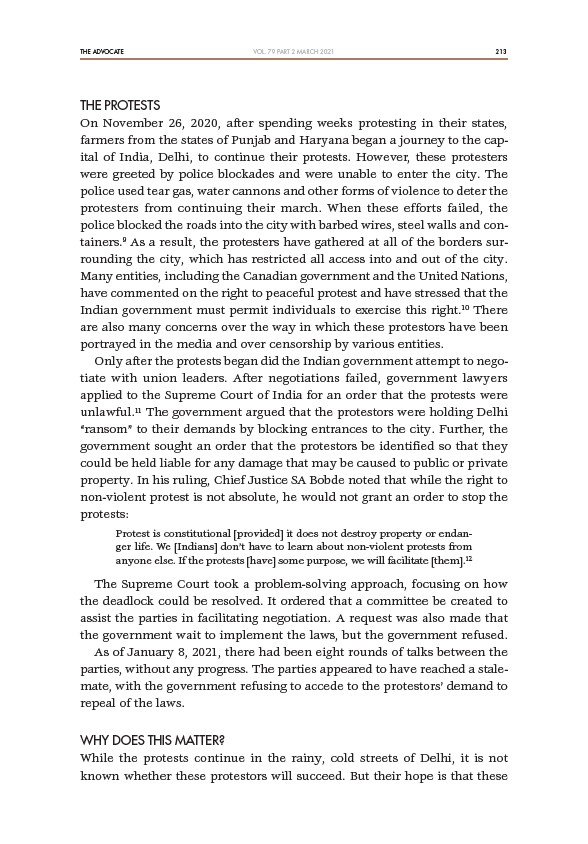
THE ADVOCATE 213
VOL. 79 PART 2 MARCH 2021
THE PROTESTS
On November 26, 2020, after spending weeks protesting in their states,
farmers from the states of Punjab and Haryana began a journey to the capital
of India, Delhi, to continue their protests. However, these protesters
were greeted by police blockades and were unable to enter the city. The
police used tear gas, water cannons and other forms of violence to deter the
protesters from continuing their march. When these efforts failed, the
police blocked the roads into the city with barbed wires, steel walls and containers.
9 As a result, the protesters have gathered at all of the borders surrounding
the city, which has restricted all access into and out of the city.
Many entities, including the Canadian government and the United Nations,
have commented on the right to peaceful protest and have stressed that the
Indian government must permit individuals to exercise this right.10 There
are also many concerns over the way in which these protestors have been
portrayed in the media and over censorship by various entities.
Only after the protests began did the Indian government attempt to negotiate
with union leaders. After negotiations failed, government lawyers
applied to the Supreme Court of India for an order that the protests were
unlawful.11 The government argued that the protestors were holding Delhi
“ransom” to their demands by blocking entrances to the city. Further, the
government sought an order that the protestors be identified so that they
could be held liable for any damage that may be caused to public or private
property. In his ruling, Chief Justice SA Bobde noted that while the right to
non-violent protest is not absolute, he would not grant an order to stop the
protests:
Protest is constitutional provided it does not destroy property or endanger
life. We Indians don’t have to learn about non-violent protests from
anyone else. If the protests have some purpose, we will facilitate them.12
The Supreme Court took a problem-solving approach, focusing on how
the deadlock could be resolved. It ordered that a committee be created to
assist the parties in facilitating negotiation. A request was also made that
the government wait to implement the laws, but the government refused.
As of January 8, 2021, there had been eight rounds of talks between the
parties, without any progress. The parties appeared to have reached a stalemate,
with the government refusing to accede to the protestors’ demand to
repeal of the laws.
WHY DOES THIS MATTER?
While the protests continue in the rainy, cold streets of Delhi, it is not
known whether these protestors will succeed. But their hope is that these